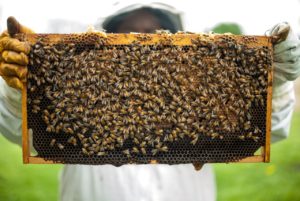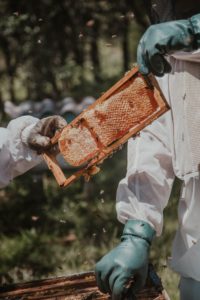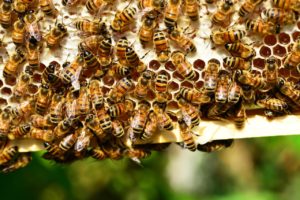What is an Apiary?
What is an apiary, and how does it work? In short, an apiary is any location where you keep bees or beehives.
 An apiary might be where you keep bees, but there’s certainly more to it than that. Bees have a complex and sophisticated way of life, and as some of our primary pollinators, it’s worth understanding how they work.
An apiary might be where you keep bees, but there’s certainly more to it than that. Bees have a complex and sophisticated way of life, and as some of our primary pollinators, it’s worth understanding how they work.
How Many Hives Do You Need for an Apiary?
One of the incredible things about apiaries is how versatile they are. There’s no set number of hives or bees you need for an area to be considered an apiary. Backyard beekeepers often keep a smaller number of hives, while higher producing, more permanent apiaries often contain up to 35 hives. However, some apiaries can a hundred hives or more for commercial honey production.
The major limiting factors on apiary size include:
- Land or space available
- Climate
- Resources available
- Expertise
- Sustenance available for bees
- Labor or number of beekeepers
What Do You Need for Beekeeping?
We’ll cover the equipment and resources you need for beekeeping in much more detail later. For now, let’s just look at the basics:
First, you need a place to keep hives. The number of hives or colonies you can keep really depends on the space available to you. You also need the ability to properly feed your bees, and have a climate suitable to the species you choose. Environment aside, there are some basic tools a beekeeper of any skill level needs:
- Bottom board – Consider this the base of the hive. The hive will sit on the bottom board, but most people also use supports to raise the board off the ground.
- Supers – These are the larger boxes that hold the frames, and ultimately the hive. These often hold 10 frames where bees store honey and their young. These are also called brood chambers or hive bodies.
- Frames – Frames are much what they sound like. They’re often wooden square frames that sit within the super, and most have beeswax or plastic foundations, often with premade hexagonal imprints.
- Queen excluder – This piece keeps the pollen, brood, and queen separated from the supers, where bees collect honey. While they aren’t always used, they can be helpful if beekeepers only have one hive body.
- Inner cover – It provides insulation against weather, but it also prevents bees from using wax and propolis to attach the honeycombs to the outer cover.
- Outer cover – The main function is protecting the hive from weather, but it can also make smoking the colony easier.
- Hive tool – Beekeepers use these to do a variety of tasks. First, a hive tool helps separate frames, but it also can be used to clean off excess wax or propolis.
- Smoker – These essentially produce thick clouds of smoke which beekeepers then direct into the hive. Smoking helps prevent stings while working with bees, but it also keeps the hive calmer.
- Bee veil – The bee veil is often attached to a hat, although the do also come as standalone items. Bee veils should be at least a few inches from your face to provide ample protection.
- Gloves – While it’s always recommended to wear gloves, not all beekeepers do. However, gloves do help prevent accidental stings. Most beekeeping gloves are made from leather or thick fabrics like canvas.
- Bee suit – Some beekeepers may not use a bee suit, per se, but no matter what, you need thick, protective clothing. Protection aside, one big benefit of a bee suit is that it also keeps regular clothing from getting sticky with propolis.
All apiary equipment comes in a variety of different dimensions, materials, and styles. Of course, once you learn more about beekeeping, you can decide what’s right for your hive.
How Do Bees Make Honey?
Bees have two different stomachs. One is for food and the other is for honey. While bees do eat honey as their food, that isn’t what the honey stomach is for. Bees go from flower to flower and collect nectar or pollen in their honey stomach. They continue collecting nectar until their honey stomach is full. Once their honey stomach is full, they return to the hive and give the nectar to the bees in charge of making honey. Often, bees pass the nectar from one to another in a line (by mouth), which also adds natural enzymes to the mix. They chew up the nectar and deposit it into cells in the honeycomb (the hexagonal shaped wax cells you’re familiar with).
 However, the honey isn’t quite ready yet. The younger worker bees then take over. These are some of the most recently hatched bees, and this is one of their first jobs. When bees first deposit the nectar, it’s much more liquid than the honey you see in stores. These younger worker bees beat their wings over the newly filled honey cells, which evaporates some of the liquid. Then, once the honey is sufficiently thickened, the bees use beeswax to cover the cell and create a seal.
However, the honey isn’t quite ready yet. The younger worker bees then take over. These are some of the most recently hatched bees, and this is one of their first jobs. When bees first deposit the nectar, it’s much more liquid than the honey you see in stores. These younger worker bees beat their wings over the newly filled honey cells, which evaporates some of the liquid. Then, once the honey is sufficiently thickened, the bees use beeswax to cover the cell and create a seal.